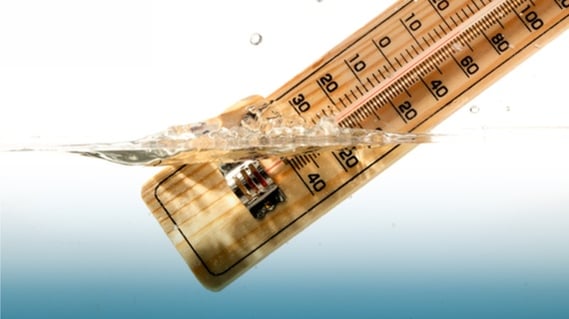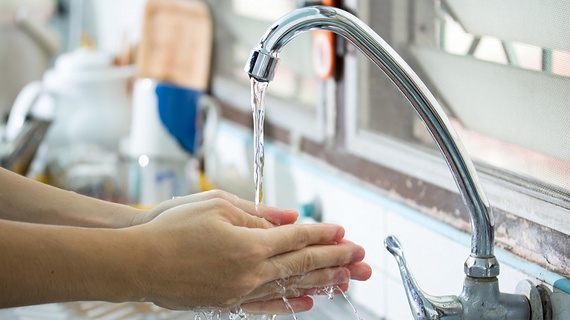
Arguably one of the most vitally important parts of keeping abreast of any potential legionella risks is the routine monitoring of core temperatures found in any water storage facility on your business premises. With the legionella bacteria specifically prone to manifesting in water where temperatures range between 20 - 45°C, (the bacteria remains dormant sub-20°C and won’t survive above 60°C), when aided and abetted by other nutrients this perfect storm of conditions provides a rich breeding ground for what commonly materialises as the - potentially fatal - Legionnaire’s Disease. Crucially, if and when the resultant airborne water droplets compromise the airspace of humans, and with an array of possible vehicles for this interaction – primarily conventional hot and cold water outlets - then there are very real dangers lurking around every corner, both in commercial and domestic scenarios.
Therefore legionella threats stand a fighting chance of being nipped in the bud before they have the opportunity to take hold, should those individuals tasked with the responsibility of habitually scrutinising stored water installations in businesses, organisations, public spaces, etc perform regular temperature checks. In terms of the all-important when and where aspect, the former should be carried out on at the very least, a monthly cycle, while the latter focuses on various junctures throughout the particular water system in situ. Broadly speaking, the temperatures need then to be recorded and subsequently collated, so as to build a bigger picture with which to ultimately shape the on-going and medium-to-long term plan of action required to control and improve the management of legionella risks. With direct reference to precisely how these checks are physically undertaken and the exact schedule involved, be sure to refer to our handy free guide to in-house monitoring tasks; which you can download here.
Bearing the Above in Mind, How Would a Person Responsible for Legionella Control Carry Out Temperature Monitoring?
So, the next question is just how the relevant party carry out such legionella control checks when it comes to temperature monitoring, and the answer is a relatively straightforward one, you’ll be pleased to learn. Split into the three predominant types of water storage installations, the following pointers affords users a bite-sized low-down on best practice procedures and protocol from the outset. First up we take a look at checking the water temperatures from hot taps, which involves the application of an accurate thermometer in order to ascertain the water flow from a designated hot water outlet. When completing this check for the first time, experts suggest choosing the tap located most distant from the calorifier/water heater/boiler, which is more often referred to as the sentinel outlet. During future monitoring exercises, alternative representative points can be given the once over in a dedicated pattern for example; thereafter the pattern can be repeated on a monthly basis so different taps are given the all-clear.
Want to learn more on how to meet legionella compliance requirements? Download our free checklist.
Is there Anything I Need to Pay Particular Attention to?
Yes, there are a few advisories as to the industry-recognised ways and means to conduct temperature monitoring in relation to legionella control. Like for instance, it’s recommended that the practitioner holds the aforementioned thermometer in the hot water flow for a minimum of one minute’s duration, whilst the temperature acknowledged should be at least 50 degrees Celsius once the minute has elapsed. In the event that the temperature falls below this benchmark, then the operative needs to make the individual charged with overall site maintenance/governance aware of the issue so that the necessary protocols can be actioned to rectify the issue. Also worth noting, the water temperature should never exceed 44 degrees Celsius if thermostatic mixing valves (TMVs) are fitted, so as to avoid scalding from hot water. If equipped, it’s imperative that hot water inlets to the TMV are checked, rather than the hot taps.
Check out our blog for all you need to know regarding TMV maintenance.
What about Monitoring Temperatures from Cold Taps and Water Heaters? What’s the Current Thinking on This?
Addressing cold tap scrutiny, and it’s traditionally adhering to the same lines as that described for the hot water; in as much as formulating – and therein, sticking to – a pattern of cold tap surveillance rotations each and every month. In terms of the practice as well as the theory, this necessitates introducing a thermometer to the cold water flow and maintaining the position for at least 2 minutes on this occasion; after which the operator needs to record the temperature. In this instance the temperature we’re looking for is 20 degrees Celsius and below; anything over this and action will be required once reported. Moving on to temperature checks from water heaters (calorifiers for example), and monthly observations are key. The means by which this type of legionella control is administered/measured is to frequent a surface temperature probe, whereby the outgoing water scanned should be at least 60°C in order to kill any virulent bacteria which presents.
Want to learn the correct method for temperature monitoring? Download our guide now.
Finally, are there any Other Water Temperature Checks That Need Routine Executing?
Yes. Together with the monthly documenting of water temperatures which span both the flow and return from and to the calorifier, it’s essential that cold water storage tanks have their temperature analysed every 6 months. Within the parameters of this monitoring process the individual tasked with legionella control/management must study the temperature recorded at the ball valve, the mains water temperatures at the juncture of tank entry and subsequently compile notes which confirm said temperatures as depicted on the tank’s thermometer; providing it has one. The maintaining of accurate records is of paramount importance re: water temperature study per se, and systematically entails logging clear data in terms of which taps - or tanks – are checked each time, while also carefully transcribing where they are, which person inspected them, when they were surveyed and detailing anything that was amiss (and cataloguing what was done to remedy the situation). What’s more, all records should always be kept for a minimum of 5 years.






